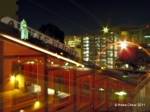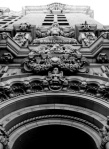
In bookstores, I pick up books at random and flip them open to see what phrases move me. A copy of Damn Good Advice (For People with Talent!): How To Unleash Your Creative Potential by George Lois recently caught my eye. Lois bills himself as “America’s Master Communicator”. I was curious yet skeptical. However, he had me at bon mot 113. “Extoll your Mentors.” This post is dedicated to three of my mentors: Bob Lank, Sandy Thornton-Trump, and Ron Vermette.
In the past four months, I have: quit a job; traveled with Scott to Italy, Germany, and France; renewed many friendships; visited Mama Chow in Canada; started a new job; and helped Scott move to Berkeley, where he will be working for the coming year. A major catalyst for this frenetic cycle of good fortune is my mentor, Bob Lank. When I lacked the confidence to leave my job for the unknown, Bob advised me to take a leap of faith. He declared, “Helsa, this year is going to be about betting on yourself.” I heeded his counsel and traveled to Venice, where Scott was attending a conference; I took this photo of the Basilica Cattedrale Patriarcale di San Marco as Scott and I walked to Harry’s Bar for dinner one evening. Bob was assigned to be my mentor during my second year of business school. Over the years, Bob has coached me through several professional and personal transitions. He has become my confidante and my friend. He and his wife were guests at our Chinese wedding banquet; Scott and I have been guests at their Sunday dinners. Now that we live 2,200 miles (3,500 km) apart, it’s difficult for us to meet for dinner but Bob always has a few words of wisdom for me each time I contemplate a job offer or move to a new city.
Sandy Thornton-Trump was a Professor of Mechanical Engineering at my alma mater. I don’t remember how we met. I do remember the hours we spent talking in his office as I transcribed his lectures on Automotive Design, typed his correspondence, and tidied his desk. He was visually impaired, so he needed an extra set of eyes to stay organized at work. Even though he was blind, he could see that I felt a bit lost at the time. He was generous with his sympathy. Before and after I graduated from engineering school, we would meet for lunch at the Faculty Club to gossip and puzzle over the small intrigues of our lives. We shared sorrow and joy: he and his wife helped me to cope with my father’s death; I had the pleasure of meeting their little grandson; they vetted and approved of Scott. The final time I saw Sandy was soon after my honeymoon. Scott’s parents had hosted a reception on their farm to celebrate our marriage but Sandy and his wife had declined to attend. I paid Sandy a visit and sadly found him in ill-health. He passed away three months after our visit.
Ron Vermette was my teacher in Grade 3. Mr. V made learning fun for me. More importantly, he proved that it’s possible to do great work and remain true to oneself: his long hair, Chuck Taylors, Winnipeg Jets jersey, convertible, and proficiency at air guitar were incidental to his talent for opening minds to new ideas. He shook up my eight-year-old reverence for orthodoxy and for that I remain grateful. He taught me how to tie-dye fabric, tool copper, and mold plaster of Paris. I still enjoy getting my hands dirty to learn something new. He used to print math exercises on top of cartoon characters, so that his students could colour in the cartoons as they learned to add and subtract. I still have a collection of booklets that I wrote and illustrated in his class – he had taught me how to sew the pages together. A couple of years ago, I wrote Mr. V and asked him if he had continued to play floor hockey, build reading caves, and make art with his students. He responded to my note and I was happy to learn that after 33 years of teaching, he was still having fun. He still plays floor hockey once a week and he still has a reading cave in his classroom. He still has long hair but has “traded in the hot car for a Jeep“. Mr. V plans to retire next year. Before he retires, I will send him another note.











